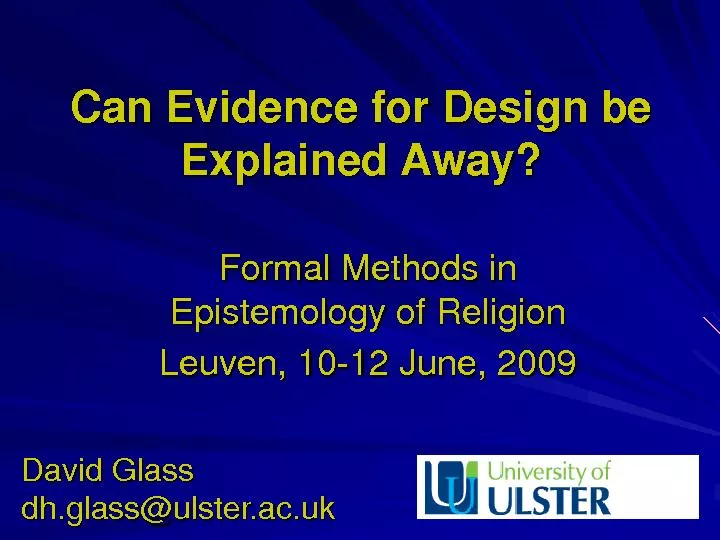/


Explained Away Formal Methods in Epistemology of Religion Leuven 10 12 June 2009 David Glass dhglassulsteracuk Overview x2022 Design Arguments Hume vs Darwin x2022 Explaining Away x ID: 452437
Download Pdf The PPT/PDF document "Can Evidence for Design be" is the property of its rightful owner. Permission is granted to download and print the materials on this web site for personal, non-commercial use only, and to display it on your personal computer provided you do not modify the materials and that you retain all copyright notices contained in the materials. By downloading content from our website, you accept the terms of this agreement.
Can Evidence for Design be Explained Away? Formal Methods in Epistemology of Religion Leuven, 10 - 12 June, 2009 David Glass dh.glass@ulster.ac.uk Overview ⢠Design Arguments: Hume vs Darwin ⢠Explaining Away â Partial and Complete â Residual Confirmation ⢠Applications of Explaining Away to Design â Design in Biology â Fine - tuning in Cosmology ⢠Conclusions Design Arguments: Hume vs Darwin Humean responses to design: ⢠Attempt to identify flaws in the logic of the argument. ⢠Do not require a satisfactory alternative explanation. Darwinian responses to design: ⢠Some initial plausibility to design. ⢠Only reject design once a satisfactory alternative is in place. Here the focus is on the Darwinian approach. Explaining Away: terminology D: Design A: Alternative explanation E: Evidence 0 1 P(D) P(D|E) P(D|E,A) ? Confirmation: P(D|E) � P(D) Partial Explaining Away: P(D|E,A) P(D|E) Complete Explaining Away: P(D|E,A) ⤠P(D) Degree of Residual Confirmation: P(D|E,A) / P(D) Explaining Away: example 1 E: Untidiness Burglary Children P(B) = 0.01 P(C) = 0.1 P(E|B,C) = 0.9 P(E|B,¬C) = 0.8 P(E|¬B,C) = 0.6 P(E|¬B,¬C) = 0.001 P(B|E) = 0.118 � 0.01 = P(B) â E confirms B. P(B|E,C) = 0.0149 (B|E) â Almost Complete Exp. Away. P(B|E,C) / P(B) = 1.49 â Low degree of residual confirmation. Explaining Away: example 2 E: Untidiness Burglary Children P(B) = 0.01 P(C) = 0.1 P(E|B,C) = 0.8 P(E|B,¬C) = 0.8 P(E|¬B,C) = 0.01 P(E|¬B,¬C) = 0.001 P(B|E) = �0.81 0.01 = P(B) â E confirms B. P(B|E,C) = 0.447 (B|E) â Partial Exp. Away. P(B|E,C) / P(B) = 44.7 â High degree of residual confirmation. Explaining Away: example 3 Burglary E: Untidiness Children P(B) = 0.01 P(C|B) = 0.5 P(C| ¬ B) = 0.01 P(E|B,C) = 0.8 P(E|B,¬C) = 0.8 P(E|¬B,C) = 0.01 P(E|¬B,¬C) = 0.001 P(B|E) = 0.881 � 0.01 = P(B) â E confirms B. P(B|E,C) = 0.976 (B|E) â No Partial Exp. Away. P(B|E,C) / P(B) = 97.6 â High degree of residual confirmation. - ve +ve Design in Biology D: Design (by God) gives rise to living organisms N: Natural / Evolutionary Processes give rise to living organisms E: Complex living organisms exist Background knowledge: laws of physics (including constants) and conditions in early universe. Design in Biology: independence D N E Does E confirm D? P(E|D) = P(E|D,N) P(N) + P(E|D, ¬ N) P(¬N) P(E| ¬ D) = P(E|¬D,N) P(N) + P(E|¬D,¬N) P(¬N) Partial Explaining away? (See corollary 1) P(E|D,N) P(E|¬D,¬N) P(E|¬D,N) P(E|D,¬N) ? Design in Biology: independence Complete Explaining Away? (See corollary 2) P(E|D,N) ⤠P(E|¬D,N) ? Richard Dawkins: âMark Ridley ⦠has suggested that the origin of the eucaryotic cell ⦠was an even more momentous, difficult and statistically improbable step than the origin of life. The origin of consciousness might be another major gap whose bridging was the same order of improbability.â Design in Biology: independence No probabilistic modus tollens so a small value for P(E|¬D,N) doesnât establish much on its own. But what about the degree of residual confirmation? becomes the key term. Design in Biology: general case D N E Does E confirm D? P(E|D) = P(E|D,N) P(N|D) + P(E|D, ¬ N) P(¬N|D) P(E| ¬ D) = P(E|¬D,N) P(N|¬D) + P(E|¬D,¬N) P(¬N|¬D) Richard Dawkins: âinitial stroke of luckâ suggests P(N|D) > P(N|¬D) - ve +ve Design in Biology: general case Partial Explaining away? (See theorem 1) P(E|D,N) P(E|¬D,¬N) P(E|¬D,N) P(E|D,¬N) P(N|D)P( ¬N|¬D) × P(N|¬D)P(¬N|D) Complete Explaining Away? (See theorem 2) P(E|D,N) P(N|D) ⤠P(E|¬D,N) P(N|¬D) What about the degree of residual confirmation? Fine - Tuning D: A Designer, i.e. God, exists M: A Multiverse exists E: A universe with physical constants suitable for life exists Background knowledge: existence of a universe with laws of physics (excluding constants). Fine - Tuning: independence D M E Does E confirm D? P(E|D) = P(E|D,M) P(M) + P(E|D, ¬ M) P(¬M) P(E| ¬ D) = P(E|¬D,M) P(M) + P(E|¬D,¬M) P(¬M) Partial Explaining away? (See corollary 1) P(E|D,M) P(E|¬D,¬M) (E|¬D,M) P(E|D,¬M) ? Fine - Tuning: independence Complete Explaining Away? (See corollary 2) P(E|D,M) ⤠P(E|¬D,M) ? Since P(E|¬D,M) â 1 complete explaining away does occur (or almost). Fine - Tuning: general case D M E Robin Collins: P(M|D) � P(M|¬D) Does F completely undermine D? (See theorem 4) P(F|M) [ P(E|D,M)P(M|D) â P(E|¬D,M)P(M|¬D) ] ⤠P(F|¬M) [ P(E|¬D,¬M)P(¬M|¬D) â P(E|D,¬M)P(¬M|D) ] - ve F +ve Fine - Tuning: general case What is the degree of residual confirmation? Summary ⢠Explaining away is an obvious strategy for defeating design arguments. ⢠Need to distinguish between Partial and Complete explaining away. ⢠Need to consider residual confirmation. ⢠Evidence can impact design hypothesis via different pathways. ⢠Evolutionary processes partially explain away evidence for design, but not completely. ⢠Fine - tuning provides significant confirmation of design, because there is no sufficiently good evidence for a multiverse and a multiverse would itself point to design.